Aetiology
Congenital phimosis is physiological by nature and is due to the adherence of the inner epithelial lining of the foreskin to the glans penis.[7][19] Congenital phimosis is expected in children younger than 3 years age, and may be a normal finding up until the age of puberty.
Acquired (pathological) phimosis is usually the result of chronic inflammation (which has also been associated with an increased risk for penile cancer), balanitis xerotica obliterans (lichen sclerosis), repeated infections, or repeated forced retraction of physiologically phimotic foreskin.[20][21][22]
Paraphimosis is most often iatrogenic (failure to reduce foreskin after examination or procedure).[23][24] Rarer causes of acquired phimosis include trauma (piercings), or prolonged erection.[25][26]
Hypospadias is thought to result from arrested development during embryonic formation of the urethra, resulting in a urethral meatus that is located more proximally. Risk factors for hypospadias include low birth weight, preterm delivery, gestational diabetes, maternal obesity, maternal hypertension, older maternal age, and steroid 5-alpha-reductase type 2 (SRD5A2) gene polymorphism.[16][27][28][29] Studies report familial aggregation of hypospadias in 13% to 22% of affected cases.[27][30]
Buried penis is thought to be due to dysgenetic dartos tissue during development. However, several other factors contribute, including fat distribution and amount of penile skin present.[31] Secondary causes include scarring from trauma or circumcision, or other tissue swelling (e.g., hernia or hydrocele).[Figure caption and citation for the preceding image starts]: Physiological phimosisFrom the collection of Nicol Corbin Bush, MD [Citation ends].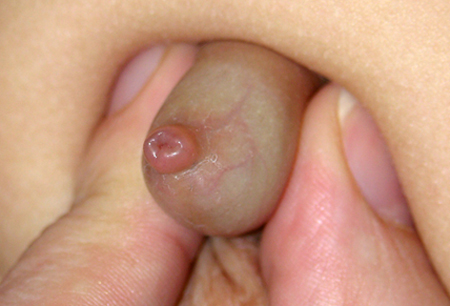 [Figure caption and citation for the preceding image starts]: Pathological phimosis with cicatrixFrom the collection of Warren T. Snodgrass, MD [Citation ends].
[Figure caption and citation for the preceding image starts]: Pathological phimosis with cicatrixFrom the collection of Warren T. Snodgrass, MD [Citation ends]. [Figure caption and citation for the preceding image starts]: Balanitis xerotica obliterans (lichen sclerosis)From the collection of Warren T. Snodgrass, MD [Citation ends].
[Figure caption and citation for the preceding image starts]: Balanitis xerotica obliterans (lichen sclerosis)From the collection of Warren T. Snodgrass, MD [Citation ends].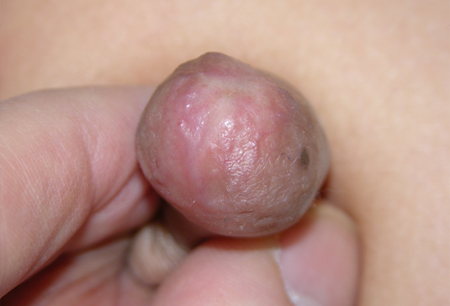
Pathophysiology
The prepuce in severe phimosis is characterised by a sclerotic, white ring (cicatrix) at the tip. It often occurs secondarily after a period of normal retractability of the foreskin.[32] Paraphimosis occurs when the foreskin becomes trapped behind the corona of the glans penis for a prolonged time, which may impair local blood and lymphatic flow.[33]
The molecular mechanisms responsible for the development of hypospadias in humans are not yet fully understood. The pathogenesis of congenital penile curvature and/or torsion is unknown; however, it is thought to result from dysplastic dartos attachments and/or disproportion of the corporal bodies.[11][13] In cases of congenital (rather than acquired) forms of buried penis, the condition manifests due to dysgenetic dartos tissue with abnormal attachments to the underlying cavernosal tissue.[34][Figure caption and citation for the preceding image starts]: Congenital buried penisFrom the collection of Nicol Corbin Bush, MD [Citation ends].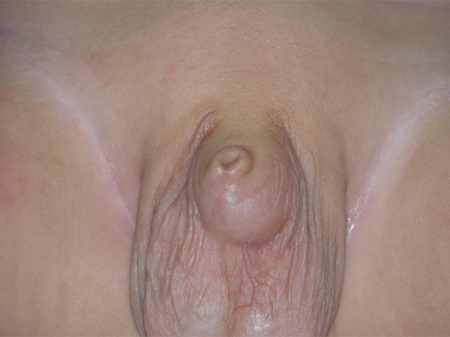 [Figure caption and citation for the preceding image starts]: Congenital buried penis: abundant inner preputial skin with paucity of shaft skinFrom the collection of Nicol Corbin Bush, MD [Citation ends].
[Figure caption and citation for the preceding image starts]: Congenital buried penis: abundant inner preputial skin with paucity of shaft skinFrom the collection of Nicol Corbin Bush, MD [Citation ends].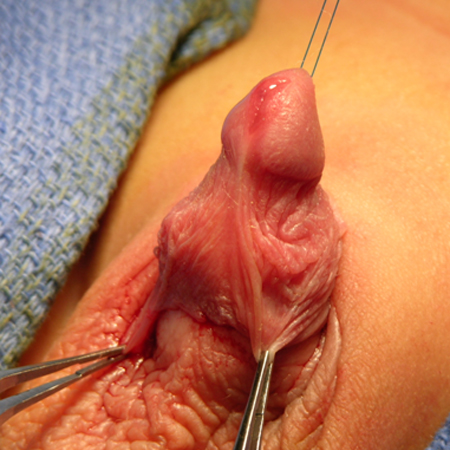 [Figure caption and citation for the preceding image starts]: Congenital buried penisFrom the collection of Warren T. Snodgrass, MD [Citation ends].
[Figure caption and citation for the preceding image starts]: Congenital buried penisFrom the collection of Warren T. Snodgrass, MD [Citation ends]. [Figure caption and citation for the preceding image starts]: Repaired congenital buried penis (with bilateral hernia repair and scrotoplasty)From the collection of Warren T. Snodgrass, MD [Citation ends].
[Figure caption and citation for the preceding image starts]: Repaired congenital buried penis (with bilateral hernia repair and scrotoplasty)From the collection of Warren T. Snodgrass, MD [Citation ends]. [Figure caption and citation for the preceding image starts]: Congenital buried penisFrom the collection of Nicol Corbin Bush, MD [Citation ends].
[Figure caption and citation for the preceding image starts]: Congenital buried penisFrom the collection of Nicol Corbin Bush, MD [Citation ends].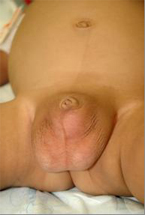 [Figure caption and citation for the preceding image starts]: Repaired congenital buried penisFrom the collection of Nicol Corbin Bush, MD [Citation ends].
[Figure caption and citation for the preceding image starts]: Repaired congenital buried penisFrom the collection of Nicol Corbin Bush, MD [Citation ends].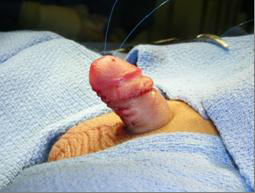
Classification
Glans-Urethral Meatus-Shaft Score (GMS Score)[2][3]
The GMS score describes hypospadias severity.
A GMS score of 1 to 4 is reported for each of the three penile components (G - glans size/urethral plate quality; M - meatal location; and S - degree of shaft curvature).
G (glans/urethral plate score)
Above average glans size; healthy urethral plate; deeply grooved
Average glans size; adequate urethral plate; grooved
Small glans size; urethral plate narrow with some fibrosis; flat
Very small glans size; urethral plate indistinct; very narrow or flat
M (meatus score)
Glanular
Coronal sulcus
Distal or mid-shaft
Proximal shaft, penoscrotal or perineal
S (shaft score)
No chordee
Mild (<30 degree) chordee
Moderate (30-60 degree) chordee
Severe (>60 degree)
Mild hypospadias: GMS score 3 to 6; moderate: GMS 7 to 9; severe GMS 10 to 12.
Use of this content is subject to our disclaimer